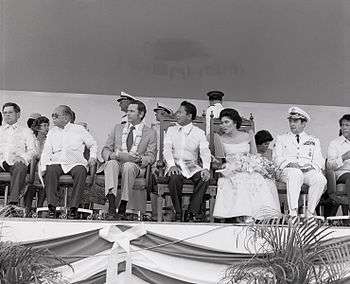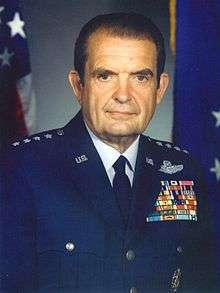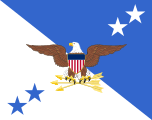David C. Jones
| David C. Jones | |
|---|---|
|
Jones in 1978 | |
| Birth name | David Charles Jones |
| Born |
July 9, 1921 Aberdeen, South Dakota |
| Died |
August 10, 2013 (aged 92) Potomac Falls, Virginia |
| Buried at | Arlington National Cemetery |
| Allegiance |
|
| Service/branch |
|
| Years of service | 1943–1982 |
| Rank | General |
| Battles/wars |
World War II Korean War Vietnam War |
| Awards |
Defense Distinguished Service Medal Air Force Distinguished Service Medal Legion of Merit Air Medal Bronze Star Federal Republic of Germany Merit Cross of the Federal Republic (Order of Merit) |
David Charles Jones (July 9, 1921 – August 10, 2013) was a U.S. Air Force general and the ninth Chairman of the Joint Chiefs of Staff.[1]
Early life
Born in Aberdeen, South Dakota, and raised in Minot, North Dakota, Jones graduated from Minot High School and attended both the University of North Dakota in Grand Forks and Minot State Teacher's College. While attending college, he received his private pilot license from the Civilian Pilot Training Program. In April 1942, he left college to join the U.S. Army Air Corps.[2]
Military career
In February 1943, Jones graduated from Roswell Army Airfield flight school in New Mexico, received his pilot wings, and was commissioned a second lieutenant in the U.S. Army Air Forces. After serving as a flying instructor in New Mexico, Arizona and Texas, Jones was assigned to the 3rd Emergency Rescue Squadron of the Fifth Air Force in Japan in 1945. He began as a unit pilot, flying Catalina flying boats, and rose to command the squadron.
From 1948 to 1949 Jones was a unit instructor and then assistant operations and training officer with the 2236th Air Force Reserve Training Center, Godman Field, Kentucky. Also during this period, he attended specialized professional military training courses.

Jones was assigned to the 19th Bombardment Squadron at March AFB, California, in January 1950. During his years with the 19th, he rose to aircraft commander, then operations officer and finally commander of the squadron. He flew more than 300 hours on combat missions over North Korea, when the squadron was one of the first bombardment units committed to the Korean War. In May 1953 he transitioned from bombers to tankers, taking command of the 22nd Air Refueling Squadron at March. Promoted to lieutenant colonel in June 1953, he remained at March but returned to bombers the following year as commander of the 33rd Bombardment Squadron.[3]
Jones next served at Headquarters Strategic Air Command, Offutt AFB, Nebraska, during SAC's build-up period. He was assigned initially in September 1954 as an operations planner in the bomber mission branch and remained there until January 1955, when Gen. Curtis LeMay selected him as his aide. Promoted to colonel in April 1957, Jones became director of materiel and later deputy commander for maintenance of SAC's 93rd Bombardment Wing at Castle AFB, California.
Jones is a 1960 graduate of the National War College. Following that, Jones was assigned to the Air Staff's operations directorate for four years. As chief of the manned systems branch, he worked on the B-70 bomber project. He then served as deputy chief and chief of the Strategic Division. After F-100 and F-4 training, Jones assumed command of the 33rd Tactical Fighter Wing, Eglin AFB, Florida, at its activation in 1965 and bought it to operational status.

Jones then served in key staff assignments with U.S. Air Forces Europe. He received his second star in November 1967. In February 1969 Jones was assigned to Headquarters Seventh Air Force, Tan Son Nhut Airfield, Vietnam, as deputy chief of staff for operations and became vice commander in June. Promoted to lieutenant general, he returned to SAC in August 1969 as commander of the Second Air Force, headquartered at Barksdale AFB, Louisiana.
In April 1971, Jones returned to USAFE as vice commander in chief. He assumed command of USAFE and the Fourth Allied Tactical Air Force in August and was promoted to general in September. In his North Atlantic Treaty Organization (NATO) capacity as commander of the Fourth Allied Tactical Air Force, Jones directed an international planning team that integrated central region air forces into a more cohesive organization. Key to that effort was his creation of a small operational and planning headquarters, Allied Air Force, Central Europe.
Capping a career that had included operational and command positions in bomber, tanker, training and tactical fighter units as well as headquarters staff positions, Jones became Chief of Staff of the Air Force in July 1974. Jones pursued a policy of developing high-technology weapons systems. In addition, he reorganized the Air Force command structure and substantially reduced headquarters staffs. He supported modernization with such systems as the F-15, F-16, the A–10, and the E–3A. Much of the modernization program was focused on the European area, where the United States developed initiatives in response to Department of Defense and congressional interest for an increase in the capability of NATO. On 31 May 1978, Jones was awarded the Order of the Sword, the Air Force enlisted force’s highest honor for officer leadership.
Jones accompanied President Jimmy Carter to Vienna, Austria, in June 1979 for the final stage of the Strategic Arms Limitation Treaty II negotiations with the USSR. When the Soviet invasion of Afghanistan raised fears that Soviet forces there might move into neighboring Iran, where an anti-Western militant Islamic regime had taken power in early 1979, Carter created a rapid deployment force for Southwest Asia to counter any such attempt in the region. Subsequently, at the direction of the secretary of defense, Jones oversaw planning for the transformation of the Rapid Defense Force into a regional unified command. The planning for what in 1983 became the United States Central Command (USCENTCOM) was essentially completed during his chairmanship.
Jones also oversaw the planning for the rescue of the U.S. embassy personnel taken hostage in November 1979 by followers of the Iranian leader Ayatollah Khomeini, and he survived the criticism for that rescue mission's failure. During his second term as chairman, Jones worked to make the chairman, rather than the corporate JCS, the principal military adviser to the president and the secretary of defense, arguing that such a change of the National Security Act would improve the quality and timeliness of military advice and the combined readiness and effectiveness of the nation's combat forces. Jones continued his efforts toward that goal after his retirement as chairman of the JCS and saw it come to fruition with the passage of the Goldwater-Nichols Department of Defense Reorganization Act in 1986.
Jones was awarded an honorary doctorate of humane letters degree from the University of Nebraska at Omaha in 1974, an honorary doctorate of laws degree from Louisiana Tech University in 1975, and an honorary doctorate of humane letters degree from Minot State College in 1979. Jones was the final Chairman of the Joint Chiefs of Staff to be decorated for service in World War II, Korea, and Vietnam.
Jones was a member of the Air Force Association, the Falcon Foundation, the Council on Foreign Relations, the Alfalfa Club, the Bohemian Club and the Family.[4]
Personal life and death
In 1942, he married Lois Tarbell (1921–2009). They had three children, two daughters Susan and Kathy; and a son, David Curtis.[5]
Jones died August 10, 2013. at a military retirement community in Potomac Falls, Virginia at age 92. He had Parkinson's disease.[6] Jones was buried in Arlington National Cemetery on October 25, 2013.[7]
Awards and decorations
References
- ↑ "Gen. David C. Jones". Meaningful Funerals. (obituary). August 2013. Retrieved August 8, 2016.
- ↑ GOLDSTEIN, RICHARD (14 Aug 2013). "Gen. David C. Jones, Former Chairman of Joint Chiefs, Dies at 92". The New York Times. Retrieved 28 December 2015.
- ↑ Joint History Office (2000), The Chairmanship of the Joint Chiefs of Staff 1949-1999 ISBN 0-16-050638-7
- ↑ Jeff Sharlet, The Family (Harper, 2008), p. 281
- ↑ Goldstein, Richard (2013-08-14). "Gen. David C. Jones, Former Chairman of Joint Chiefs, Dies at 92". The New York Times. Retrieved 2013-09-09.
- ↑ "GEN. DAVID C. JONES, EX-JOINT CHIEFS CHAIR, DIES". AP. Retrieved 15 August 2013.
- ↑ "Ninth CSAF laid to rest". United States Air Force. 2013-10-28. Retrieved 2014-05-17.
External links
| Wikimedia Commons has media related to David C. Jones. |
- U.S. Air Force biography
- Appearances on C-SPAN
- DVIDS – photos of Jones' funeral at Arlington, October 2013
- David C. Jones at Find a Grave
| Military offices | ||
|---|---|---|
| Preceded by Gen. George S. Brown |
Chief of Staff of the United States Air Force 1974–78 |
Succeeded by Gen. Lew Allen Jr. |
| Preceded by Gen. George S. Brown |
Chairman of the Joint Chiefs of Staff 1978–82 |
Succeeded by Gen. John William Vessey Jr. |


